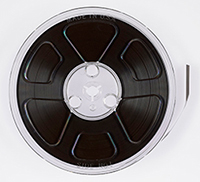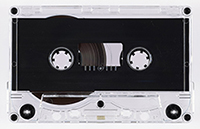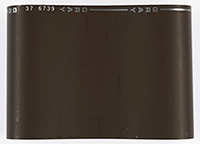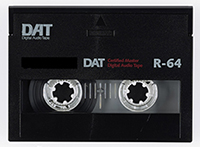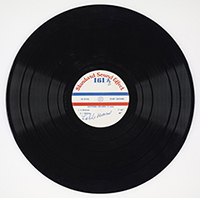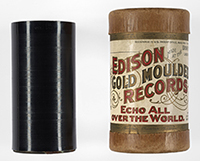4.2 Types of Audio Files
Introduction
An apparatus that uses binary code such as a computer or an iPhone manages sound in a digital format. There are many different types of playback devices and various ways these files are stored. Additionally, analog sound systems are still used to play and archive sound. An audio engineer can quickly discover there exists a vast expanse of recording formats that are not easily compatible or accessible. Understanding how the older systems work can help with most modern versions. And vice-versa. Take time to play and listen to music on a wide range of equipment from different eras. Learn how to convert one to the other and your expertise in the production field will certainly grow.
People that work in audio production need to know the differences between varying digital and analog files, how to convert one to another, and what each is best used for (technical). How we save our files, and how we transmit these files, and why we do so could be considered the method in our three pillar approach. The order in which we present these audio files or perhaps the final decision on where to share these files would fall under our creative approach.
For example, in the past, I’ve been hired to convert a client’s old 78 vinyl record collection into digital files that could be played and organized on a typical home laptop computer. That required choosing the right equipment and cables to play records at the right speed and turning that analog signal into a digital one. Once transferred to my computer, I could then make some equalization adjustments and bring the overall volume up (or down) to a presentable level. Finally, I had to convert those large files into smaller MP3 files that I could electronically send back to the client.
In addition to the audio, I scanned the liner notes and artwork and included those attachments along with with MP3s. Once again, I used my technical knowledge to identify what equipment would be needed, I used different methods and orders of operation to make quality conversions, and I topped it off with some creative approach in packaging the final product so that it was an artistically unique experience for my client.
Digital Audio File Formats
There are two major groups of audio file formats:
- Those using lossless compression, e.g. like WAV, FLAC
- Those using lossy compression, e.g. MP3, Ogg Vorbis, WMA, AAC
In the lossless compression of a piece of data, nothing is lost during the compression and the original data is restored upon uncompressing. In lossy compression, some data is lost during compression and upon uncompressing the data is not identical to the original but possibly close to it. Lossy compression is used mainly in the compression of multimedia data like audio or video where the loss of some details is tolerable under certain conditions, e.g., the human eye is unable to discern the loss in certain details of an image or video.
WAV
WAVE form audio format (WAV) is a Microsoft and IBM audio file format for storing audio on PCs. It is the main format used on Microsoft Windows systems for raw audio storage. The WAV format is most commonly used with an uncompressed, lossless storage method (pulse-code modulation) resulting in comparatively large audio files. Today, the WAV audio format is no longer popular being superseded by other more efficient means of audio storage.
FLAC
Free Lossless Audio Codec (FLAC) is a popular lossless audio format with compression designed specifically for audio data streams, achieving compression rates of 30–50 percent. The format specification is publicly available and forms part of the FLAC Open Source project. It is supported by a growing list of audio software and devices.
MP3
MPEG-1 audio layer 3 (MP3) is a popular lossy compression audio format. The MP3 specification was set by the Motion Pictures Experts Group (MPEG), a working group of ISO/IEC charged with the development of video and audio encoding standards. The compression scheme and format for MP3 forms part of the MPEG-1 video and audio compression standard specifications and is an ISO standard, ISO/IEC 11172-3.
MP3 is one of the most popular audio file formats in use today. Music files encoded with MP3 are particularly popular on music exchange and download sites on the Internet due, in part, to the relatively small size of such files and the wide availability of free software on PCs that allow easy creation, sharing, collecting and playing of MP3 files.
WMA
Windows Media Audio (WMA) is a lossy compression audio file format developed by Microsoft. It is a proprietary format but is widely used and supported due to the popularity of the MS Windows platform.
AAC
Advanced Audio Coding (AAC) from MPEG is a lossy data compression scheme intended for audio streams. It was designed to provide better quality at the same bit-rate than MP3, or the same quality at lower bitrates (and hence smaller file sizes). The compression scheme and format for AAC forms part of the MPEG2 video and audio compression standard specifications and is an ISO standard, ISO/IEC 13818-7. This MPEG-2 AAC specification makes use of patents from several companies and a patent license is needed for products that make use of this standard.
The newer MPEG-4 standard also specifies an audio compression technology that incorporates MPEG-2 AAC. This is known as MPEG-4 AAC, and is an ISO standard, ISO/IEC 14496-3.
Apple’s popular iTunes service and iPod products have music available in AAC and this has led to an upsurge in the popularity of AAC despite the required patent license royalty payments.
RealAudio
RealAudio is a proprietary audio format developed by RealNetworks for low bandwidth usage. It was first introduced in 1995 and it became popular especially for streaming audio, i.e., the audio is being played in real time as it is downloaded. Many radio stations use RealAudio to stream their programs over the Internet.
Ogg Vorbis
Ogg Vorbis is a compressed audio format that is believed to be free of patents and royalty payments. The format originated from the Xiph.Org Foundation, a non-profit organization dedicated to producing free and open protocols, formats and software for multimedia.
Ogg Vorbis uses the Vorbis lossy audio compression scheme. The audio data is wrapped up in the Ogg container format, the name of Xiph.org’s container format for audio, video, and meta-data – hence the name Ogg Vorbis. The Ogg Vorbis specification is in the public domain and is completely free for commercial or non-commercial use. There is growing support for the Ogg Vorbis format from software and hardware devices as well as online audio services.
| Format | Organization | Published | Non-Proprietary | International Standard |
| WAV | Microsoft | Yes | No | No |
| FLAC | Xiph.Org | Yes | Yes | No |
| MP3 | MPEG/ISC | Yes | Yes | Yes |
| WMA | Microsoft | No | No | No |
| AAC | MPEG/ISO | Yes | Yes | Yes |
| RealAudio | RealNetworks | Yes | No | No |
| Ogg Vorbis | Xiph.org | Yes | Yes | No |
Audio Guidance: Identifying Audio Formats
Consider
- What modern audio formats are you aware of?
- Can you name an audio format used in the past that we (typically) no longer use?
How Do I Identify Audio Formats?
Sound recordings come in a variety of shapes and sizes and have been around since the late nineteenth century. While there are a number of audio formats you may find at home or in a professional environment, each one presents different requirements for identification, physical handling, and playback equipment used. Some of the more common types of audio include ¼-inch open reel tape, audio cassettes, and grooved disc recordings.
Magnetic Media
Magnetic recording tape was invented in 1928. However, it wasn’t until the late-1940s that the recording industry fully adopted the format. Compared to grooved recordings, magnetic tape offered higher fidelity, longer record times, and the ability to be edited.
¼-inch open reel audio tape is supplied in reels having a diameter of 5-inches, 7-inches, and 10.5-inches and may vary in length depending on the tape speed. 1-inch and 2-inch open reel tapes (in width) also exist and were primarily used in professional environments.
- There are different types of tape base for ¼-inch width audio tape. Acetate and polyester are most common, although you may encounter PVC or paper base as well.
- An easy way to tell if you have one of the two most common types of ¼-inch tape is to hold the tape up to a light source. If the tape appears opaque it is polyester; if the tape is translucent, it is acetate.
- Tape speeds vary between 30 ips (inches per second) to 15/16 ips, with speeds of 7.5 ips and 3.75 ips being the most common.
This tape format was introduced in the United States in the mid-1960s by Phillips. Cassette recordings have been used for a number of purposes, including oral histories, lectures, conferences, and music. Since they were primarily used for convenience and not necessarily quality, cassettes are not considered to be a stable or high fidelity medium.
- Cassettes are made with polyester base tape, have just over a 1/8th inch tape width, and a slow playback speed of 1 7/8 ips, thus contributing to a limited dynamic range and frequency response.
Wire Recording
An alternate form of magnetic recording, the wire recording was initially introduced in the late 19th century, but further developed in the US during WWII. Spools are about 3 ½-inches in diameter. This format was ultimately succeeded by tape due to its low sound quality. While stainless steel wire recordings (post WWII) are not susceptible to the same types of degradation as open-reel tapes, they may be damaged easily and playback equipment is obsolete. You may find the wire recordings in your collection date from around the 1940s-1960s.
Magnabelts
These magnetic belts are similar in appearance to dictabelts and were used for dictation purposes, but do not contain grooves.
Digital Audio Tape (DAT)
Digital Audio Tapes were introduced by Sony in 1987, and are magnetic tapes that store audio digitally. A cartridge houses a 4mm magnetic tape and recordings can be at, below, or above the 44.1 kHz sampling rate of CDs.
Grooved Recordings
You may encounter grooved discs at home or in professional collections. Discs vary in size and speed and have different coatings and substrates, which may include:aluminum, lacquer/acetate, plastic, and cardboard. Below are several of the more common types of phonograph records:
The earliest recording medium produced commercially, these are grooved wax- cylinders, which are the predecessors to the grooved disc. Wax cylinders can be solid or have a core of cardboard. They are very fragile and should be handled with care, including the grooves which can easily be scratched.
Attribution & References
Except where otherwise noted, this page is adapted from “Unit Two, Part Three: Types of Audio Files” In Audio Production Course Manual by Mark J. Lindquist, CC BY-NC-SA 4.0
- Audio file formats is adapted from: FOSS Open Standards/Comparison of File Formats , CC BY-SA
- How do I identify audio formats Courtesy of National Archives and Records Administration, PDM

 Read more about:
Read more about: